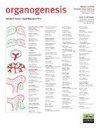不同细胞类型和来源对纤维蛋白和琼脂糖-胶原凝胶血管形成前的影响
IF 2.8
4区 生物学
Q4 BIOCHEMISTRY & MOLECULAR BIOLOGY
引用次数: 16
摘要
摘要由于营养物质的扩散限制以及缺乏与心血管系统的必要连接,血管化对于定制、组织工程化器官和组织的发展至关重要。为了预血管化,可以将内皮细胞和支持细胞嵌入支架中,以在移植后培养足够的营养和氧气供应。该技术适用于各种组织的组织工程,但很少有关于使用不同细胞类型或细胞来源的研究。我们比较了来自不同来源的支持细胞对血管形成的影响。纤维蛋白凝胶和琼脂糖-胶原水凝胶用作支架。支持细胞是原代人真皮成纤维细胞(HDFs)、人鼻腔成纤维细胞、脐带沃顿氏果冻中的人间充质干细胞(WJ MSCs)、脂肪来源的MSCs(AD MSCs)和股骨来源的MSC(BM MSCs)。将组织构建体孵育14天,并通过双光子激光扫描显微镜进行分析。血管形成受到所有细胞类型的支持,在两种水凝胶中形成管状血管结构的分支网络。通常,与琼脂糖-胶原水凝胶相比,纤维蛋白凝胶具有更高的血管生成促进环境,成纤维细胞在与内皮细胞共培养中显示出高的血管形成潜力。在琼脂糖胶原水凝胶中,AD MSC支持的血管结构在体积、面积和长度方面与我们的HDF对照组相当。BM-MSC在两种水凝胶中都形成了较小结构的均匀网络。这项研究为理解不同支持细胞类型和来源的血管形成前特性提供了数据,用于不同器官和组织的组织工程。本文章由计算机程序翻译,如有差异,请以英文原文为准。
Influence of Different Cell Types and Sources on Pre-Vascularisation in Fibrin and Agarose–Collagen Gels
ABSTRACT Vascularisation is essential for the development of tailored, tissue-engineered organs and tissues due to diffusion limits of nutrients and the lack of the necessary connection to the cardiovascular system. To pre-vascularize, endothelial cells and supporting cells can be embedded in the scaffold to foster an adequate nutrient and oxygen supply after transplantation. This technique is applied for tissue engineering of various tissues, but there have been few studies on the use of different cell types or cells sources. We compare the effect of supporting cells from different sources on vascularisation. Fibrin gels and agarose-collagen hydrogels were used as scaffolds. The supporting cells were primary human dermal fibroblasts (HDFs), human nasal fibroblasts (HNFs), human mesenchymal stem cells from umbilical cord’s Wharton’s jelly (WJ MSCs), adipose-derived MSCs (AD MSCs) and femoral bone marrow-derived MSCs (BM MSCs). The tissue constructs were incubated for 14 days and analyzed by two-photon laser scanning microscopy. Vascularisation was supported by all cell types, forming branched networks of tubular vascular structures in both hydrogels. In general, fibrin gels present a higher angiogenic promoting environment compared to agarose-collagen hydrogels and fibroblasts show a high angiogenic potential in co-culture with endothelial cells. In agarose-collagen hydrogels, vascular structures supported by AD MSCs were comparable to our HDF control in terms of volume, area and length. BM MSCs formed a homogeneous network of smaller structures in both hydrogels. This study provides data toward understanding the pre-vascularisation properties of different supporting cell types and sources for tissue engineering of different organs and tissues.
求助全文
通过发布文献求助,成功后即可免费获取论文全文。
去求助
来源期刊

Organogenesis
BIOCHEMISTRY & MOLECULAR BIOLOGY-DEVELOPMENTAL BIOLOGY
CiteScore
4.10
自引率
4.30%
发文量
6
审稿时长
>12 weeks
期刊介绍:
Organogenesis is a peer-reviewed journal, available in print and online, that publishes significant advances on all aspects of organ development. The journal covers organogenesis in all multi-cellular organisms and also includes research into tissue engineering, artificial organs and organ substitutes.
The overriding criteria for publication in Organogenesis are originality, scientific merit and general interest. The audience of the journal consists primarily of researchers and advanced students of anatomy, developmental biology and tissue engineering.
The emphasis of the journal is on experimental papers (full-length and brief communications), but it will also publish reviews, hypotheses and commentaries. The Editors encourage the submission of addenda, which are essentially auto-commentaries on significant research recently published elsewhere with additional insights, new interpretations or speculations on a relevant topic. If you have interesting data or an original hypothesis about organ development or artificial organs, please send a pre-submission inquiry to the Editor-in-Chief. You will normally receive a reply within days. All manuscripts will be subjected to peer review, and accepted manuscripts will be posted to the electronic site of the journal immediately and will appear in print at the earliest opportunity thereafter.
 求助内容:
求助内容: 应助结果提醒方式:
应助结果提醒方式:


